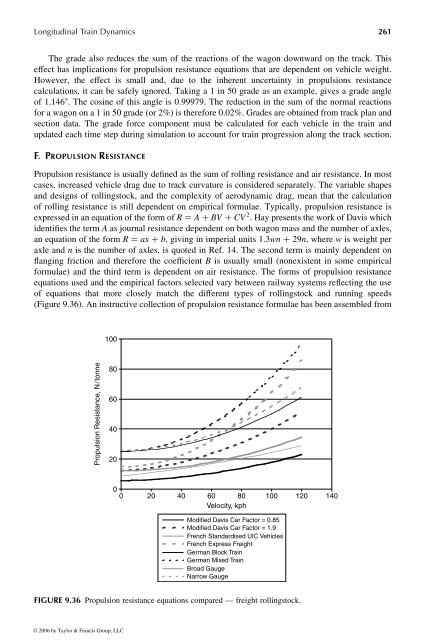Hi-Res PDF - CRCnetBASE
Hi-Res PDF - CRCnetBASE
Hi-Res PDF - CRCnetBASE
You also want an ePaper? Increase the reach of your titles
YUMPU automatically turns print PDFs into web optimized ePapers that Google loves.
Longitudinal Train Dynamics 261<br />
The grade also reduces the sum of the reactions of the wagon downward on the track. This<br />
effect has implications for propulsion resistance equations that are dependent on vehicle weight.<br />
However, the effect is small and, due to the inherent uncertainty in propulsions resistance<br />
calculations, it can be safely ignored. Taking a1in 50 grade as an example, gives agrade angle<br />
of 1.1468 .The cosine of this angle is 0.99979. The reduction in the sum of the normal reactions<br />
for awagon on a1in 50 grade (or 2%) is therefore 0.02%.Grades are obtained from track plan and<br />
section data. The grade force component must becalculated for each vehicle in the train and<br />
updated each time step during simulation to account for train progression along the track section.<br />
F . P ROPULSION R ESISTANCE<br />
Propulsion resistance isusually defined as the sum of rolling resistance and air resistance. In most<br />
cases, increased vehicle drag due to track curvature is considered separately. The variable shapes<br />
and designs of rollingstock, and the complexity of aerodynamic drag, mean that the calculation<br />
of rolling resistance is still dependent on empirical formulae. Typically, propulsion resistance is<br />
expressedinanequation of the form of R ¼ A þ BV þ CV 2 : Hay presentsthe workofDavis which<br />
identifies the term A as journal resistance dependent on both wagon mass and the number of axles,<br />
an equation of the form R ¼ ax þ b ,giving in imperial units 1.3wn þ 29n ,where w is weight per<br />
axle and n is the number of axles, is quoted inRef. 14. The second term is mainly dependent on<br />
flanging friction and therefore the coefficient B is usually small (nonexistent in some empirical<br />
formulae) and the third term isdependent on air resistance. The forms of propulsion resistance<br />
equations used and the empirical factors selected vary between railway systems reflecting the use<br />
of equations that more closely match the different types ofrollingstock and running speeds<br />
(Figure 9.36). An instructive collection of propulsion resistanceformulae has been assembled from<br />
Propulsion <strong>Res</strong>istance, N/tonne<br />
100<br />
80<br />
60<br />
40<br />
20<br />
0<br />
0 20 40 60 80 100 120 140<br />
Velocity, kph<br />
Modified Davis Car Factor =0.85<br />
Modified Davis Car Factor =1.9<br />
French Standardised UIC Vehicles<br />
French Express Freight<br />
German BlockTrain<br />
German Mixed Train<br />
Broad Gauge<br />
Narrow Gauge<br />
FIGURE 9.36 Propulsion resistance equations compared —freight rollingstock.<br />
© 2006 by Taylor & Francis Group, LLC









